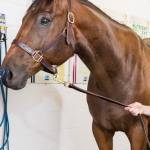Rehabilitation for Injured Horses

Years ago, the only way to rehabilitate an injured horse was either to confine it to a stall or to turn it out, often for a lengthy period of time, and wait for natural healing to take place. Months later, horses were often still unsound, and relatively few were able to return to their former level of performance. Today, equine rehab clinics have a range of treatments to control discomfort, maintain or build muscular strength, and bring the horse back to health more quickly than in times past. Some of these techniques are designed to maximize range of motion in injured joints and encourage healthy tissue growth rather than the formation of nonelastic scar tissue. Modalities may include:
- Cold water treatment. An age-old treatment with a new twist, cold-water leg spas allow a horse to stand with his legs in a pool of cold water (fresh or salty) that swirls to provide a gentle massage. Replacing cold hosing or standing in ice-water leg wraps, the spa can be used after hard workouts to reduce inflammation as well as to treat any condition that involves pain, heat, or swelling. Laminitis, soft tissue injuries, and joint problems may respond well to cold water treatment.
- Water treadmills. With its weight partially supported by liquid, a horse can avoid hoof concussion and still get an intense physical workout as it runs through deep water. The water treadmill can be a training aid for healthy horses or a way to keep an injured or post-surgical horse from losing condition as it recovers.
- Hyperbaric oxygen therapy. With the horse standing in a pressurized chamber, oxygen is forced into the blood and body tissues. The treatment helps to fight infection, heal damaged tendons, and improve recovery after strenuous exercise. It is also used to aid neonatal foals suffering from oxygen deprivation.
- Therapeutic vibration floor. Horses are led onto a vibrating platform. Physical effects are said to include improved blood circulation, burning of fat, increases in muscular strength and tone, a reduction in muscle stiffness, and an improvement in the status of horses with some types of colic.
Goals of the International Association of Veterinary Rehabilitation and the American Association of Rehabilitation Veterinarians include educating horse owners and veterinarians about the various treatment options that can be used to help horses recover after illness, injury, or surgery. For advice about immediate or long-term treatment, owners should contact their veterinarian or the nearest equine clinic.








